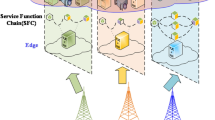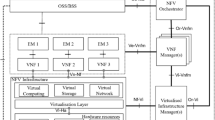Abstract
Network function virtualization (NFV) has been explored to be integrated with multi-access edge computing (MEC) to facilitate the development of 5G (fifth-generation) network. Latency-sensitive applications can be deployed as serial-parallel hybrid service function chains (SP-SFCs) in the MEC-NFV environment. SP-SFCs are deployed on resource-limited devices in the edge and therefore are vulnerable to software aging, which can reduce the SFC service dependability. Rejuvenation technique can mitigate the impact of software aging but its effectiveness is influenced by the rejuvenation trigger interval. This paper explores a semi-Markov model approach to quantitatively evaluate the impact of different rejuvenation trigger intervals on the SFC service dependability in terms of reliability and availability. In contrast to the existing studies, our model captures the behaviors of an SP-SFC system consisting of any number of SFs from suffering from software aging until recovery under the condition that time intervals of failure and recovery events follow general distributions. Our model and formulas are verified by developing a simulator. The results of numerical experiments show the optimal rejuvenation trigger intervals, which can help service providers to maximize the benefits.













Similar content being viewed by others
Explore related subjects
Discover the latest articles and news from researchers in related subjects, suggested using machine learning.References
Hsieh H-C, Chen J-L, Benslimane A (2018) 5G virtualized multi-access edge computing platform for IoT applications. J Netw Comput Appl 115:94–102
Sonkoly B, Haja D, Németh B, Szalay M, Czentye J, Szabó R, Ullah R, Kim B-S, Toka L (2020) Scalable edge cloud platforms for IoT services. J Netw Comput Appl 170
Fang L, Zhang X, Sood K, Wang Y, Shui Yu (2020) Reliability-aware virtual network function placement in carrier networks. J Netw Comput Appl 154
Zhang Y, Anwer B, Gopalakrishnan V, Han B, Reich J, Shaikh A, Zhang ZL (2017) ParaBox: exploiting parallelism for virtual network functions in service chaining. SOSR 143–149
Luo J, Li J, Jiao L, Cai J (2021) On the effective parallelization and near-optimal deployment of service function chains. IEEE Trans Parallel Distributed Syst 32(5):1238–1255
Lin IC, Yeh YH, Lin KCJ (2021) Toward optimal partial parallelization for service function chaining. IEEE/ACM Trans Netw (Early Access)
Yue Yi, Cheng Bo, Li B, Wang M, Liu X (2020) Throughput optimization VNF placement for mapping SFC requests in MEC-NFV enabled networks. MobiCom 90(1–90):3
Silva L, Madeira H, Silva JG (2006) Software aging and rejuvenation in a SOAP-based server. NCA 56–65
Matias R, Andrzejak A, Machida F, Elias D, Trivedi KS (2014) A systematic differential analysis for fast and robust detection of software aging. SRDS 311–320
Grottke M, Li L, Vaidyanathan K, Trivedi KS (2006) Analysis of software aging in a web server. IEEE Trans Reliab 55(3):411–420
Cotroneo D, Natella R, Pietrantuono R, Russo S (2010) Software aging analysis of the linux operating system. ISSRE 71–80
Long Qu, Khabbaz M, Assi C (2018) Reliability-aware service chaining in carrier-grade softwarized networks. IEEE J Sel Areas Commun 36(3):558–573
Engelmann A, Jukan A (2018) A reliability study of parallelized VNF chaining. ICC 1–6
Wang M, Cheng B, Wang S, Chen J (2021) Availability-and traffic-aware placement of parallelized SFC in data center networks. IEEE Trans Netw Serv Manag (Early Access)
Yang D-Y, Wu CH (2021) Evaluation of the availability and reliability of a standby repairable system incorporating imperfect switchovers and working breakdowns. Reliab Eng Syst Saf 207
Rui L, Chen X, Wang X, Gao Z, Qiu X, Wang S (2019) Multiservice reliability evaluation algorithm considering network congestion and regional failure based on petri net. IEEE Trans Serv Comput (Early Access)
Di Mauro M, Longo M, Postiglione F (2020) Availability evaluation of multi-tenant service function chaining infrastructures by multidimensional universal generating function. IEEE Trans Serv Comput (Early Access)
Torquato M, Maciel P, Vieira M (2020) Availability and reliability modeling of VM migration as rejuvenation on a system under varying workload. Softw Qual J 28(1):59–83
Zhu H, Bai J, Chang X, Misic J, Misic V, Yang Y (2020) Stochastic model-based quantitative analysis of edge UPF service dependability. ICA3PP (2):619–632
Bai J, Chang X, Machida F, Trivedi KS, Han Z (2020) Analyzing software rejuvenation techniques in a virtualized system: Service provider and user views. IEEE Access 8:6448–6459
Bai J, Chang X, Ning G, Zhang Z, Trivedi KS (2020) Service availability analysis in a virtualized system: a markov regenerative model approach. IEEE Trans Cloud Comput (Early Access)
Bai J, Chang X, Trivedi KS, Han Z (2021) Resilience-driven quantitative analysis of vehicle platooning service. IEEE Trans Veh Technol 70(6):5378–5389
Guedes E, Maciel P (2019) Stochastic model for availability analysis of service function chains using rejuvenation and live migration. ISSRE Workshops 211–217
Tola B, Nencioni G, Helvik BE (2019) Network-aware availability modeling of an end-to-end NFV-enabled service. IEEE Trans Netw Serv Manag 16(4):1389–1403
Cai J, Huang Z, Luo J, Liu Y, Zhao H, Liao L (2020) Composing and deploying parallelized service function chains. J Netw Comput Appl 163
Xie W, Hong Y, Trivedi KS (2005) Analysis of a two-level software rejuvenation policy. Reliab Eng Syst Saf 87(1):13–22
Machida F, Xiang J, Tadano K, Maeno Y (2017) Lifetime extension of software execution subject to aging. IEEE Trans Reliab 66(1):123–134
Cziva R, Pezaros DP (2017) Container network functions: Bringing NFV to the network edge. IEEE Commun Mag 55(6):24–31
Trubiani C, Meedeniya I, Cortellessa V, Aleti A, Grunske L (2013) Model-based performance analysis of software architectures under uncertainty. QoSA 69–78
Trivedi KS, Bobbio A (2017) Reliability and availability engineering: Modeling, analysis, and applications. Cambridge University Press
Tola B, Jiang Y, Helvik BE (2021) Model-driven availability assessment of the NFV-MANO with software rejuvenation. IEEE Trans Netw Serv Manag 18(3):2460–2477
Maplesoft: Maple (2017). https://www.maplesoft.com/support/install/maple2017_install.html. Accessed 24 Dec 2021
Acknowledgements
The work of Jing Bai, Xiaolin Chang and Zhen Han was supported by Beijing Municipal Natural Science Foundation (No. M22037).
Author information
Authors and Affiliations
Corresponding author
Ethics declarations
Conflict of interest
The authors declare that they have no conflict of interest.
Additional information
Publisher's Note
Springer Nature remains neutral with regard to jurisdictional claims in published maps and institutional affiliations.
Appendices
Appendix A
In this section, we give the detailed process for calculating SFC service availability mentioned in Sect. 3.4 of the main paper. The notations used in this appendix are defined in Table 3 of the main paper.
The non-null elements of the TPM \({\text{P}}_{PS}\) are given by Eqs. (8)–(24),
where \(B_{i}^{{\prime}} = {{\{ }}\left. r \right|0 < r \le n{,}r \ne i{{\} ,}}\)\(C_{j}^{{\prime}} = {{\{ }}\left. {r{^{\prime}}} \right|0 < r{^{\prime}} \le m,r{^{\prime}} \ne j{{\} }}\)\(B = {{\{ }}\left. i \right|0 < i \le n{{\} ,}}\) and \(C = {{\{ }}\left. j \right|0 < j \le m{{\} }}\). The equations of calculating the steady-state probability \(V_{{PS_{i} }}\) of the EDTMC at system state \(PS_{i}\) are given by Eqs. (25)–(32),
where \(W = \sum_{i \in B} {p_{{PS_{0} PS_{2i + 1} }} } + \sum_{i \in B} {p_{{PS_{0} PS_{2i + 1} }} p_{{PS_{2i + 1} PS_{2i + 2} }} p_{{PS_{2i + 2} PS_{2} }} } {\kern 1pt} + 1\)
The general equations which can be used to calculate the mean sojourn time \(h_{{PS_{i} }}\) at system state \(PS_{i}\) are give by Eqs. (33)–(40).
Appendix B
In this section, we give the detailed process for calculating the MTTF of SFC service mentioned in Sect. 3.5 of the main paper. The notations used in this appendix are defined in Table 3 of the main paper.
The equations of calculating the expected number of visits \(V_{{PS_{i*} }}^{*}\) to system state \(PS_{i*}\) until absorption are given by Eqs. (41)–(46),
where \(M = \sum\nolimits_{j \in C} {p_{{PS_{0} PS_{2n + 3j - 2} }} p_{{PS_{2n + 3j - 2} PS_{2n + 3j - 1} }} p_{{PS_{2n + 3j - 1} PS_{0} }} } - 1\)\(+ \sum\nolimits_{j \in C} {p_{{PS_{0} PS_{2n + 3j - 2} }} p_{{PS_{2n + 3j - 2} PS_{2n + 3j} }} p_{{PS_{2n + 3j} PS_{0} }} } { + }\sum\nolimits_{i \in B} {p_{{PS_{0} PS_{2i - 1} }} } p_{{PS_{2i - 1} PS_{2i} }}\)\(p_{{PS_{2i} PS_{0} }} + \sum\nolimits_{j \in C} {p_{{PS_{0} PS_{2n + 3j - 2} }} p_{{PS_{2n + 3j - 2} PS_{2n + 3j - 1} }} p_{{PS_{2n + 3j - 1} PS_{2n + 3j} }} } p_{{PS_{2n + 3j} PS_{0} }}\).
Rights and permissions
About this article
Cite this article
Bai, J., Chang, X., Machida, F. et al. Quantitative understanding serial-parallel hybrid sfc services: a dependability perspective. Peer-to-Peer Netw. Appl. 15, 1923–1938 (2022). https://doi.org/10.1007/s12083-022-01329-0
Received:
Accepted:
Published:
Issue Date:
DOI: https://doi.org/10.1007/s12083-022-01329-0




